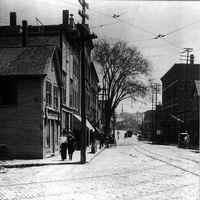Getting Down to Business

Even before their settlement, the interior towns were ransacked of timber. Although small mills were set up on Chandler’s Stream and Meadow Brook, the settlement lacked the water power that later powered mills in bordering towns. Potash was manufactured early, extracting potassium compounds from wood ashes. Trees were milled into lumber, but saw mills had low capacity. Oak bark was used in tanneries to turn cow hides into leather, and that leather was made into harnesses and shoes. Shoemaking was a substantial cottage industry as early as 1820; men and women worked on patterns and lasts provided out of Lynn factories. At the height of the shoe industry, more than 300 men and women were employed in small shops of usually five or six workers. Farms provided milk and vegetables to families in other towns. The town’s economic problem remained the scarcity of cash from the sale of exportable goods. Town obligations such as roads and schools were often met by citizens’ labor in lieu of money tax payments.
Before the Civil War, the River Road/South Bend vicinity became a trading center for a region stretching 20 miles or more northward at a time when Lewiston and Auburn had no industrial or commercial importance. Each section of town had its general store; O. Israel Bagley opened the first one in 1770, just south of where the Bagley Inn stands today. These general stores were community gathering spots where gossip, political arguments and exchanges of work were shared. At Durham’s height as a commercial center, stores around the South Bend also included a millinery, a bakery, a hotel, a tavern and an apothecary. People stopped in at their general store almost daily to pick up mail. With unanticipated consequences, the RFD mail service (established in 1920) eliminated this commerce. Without people coming into town to pick up their mail, the small stores of Durham no longer could compete with shops in Freeport, Brunswick and Auburn.

